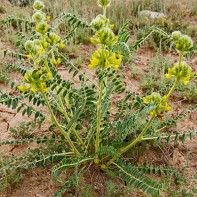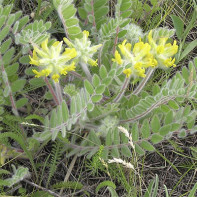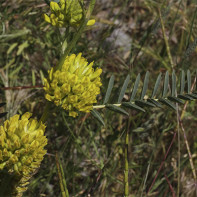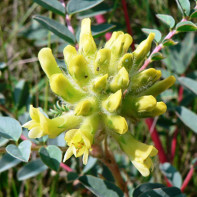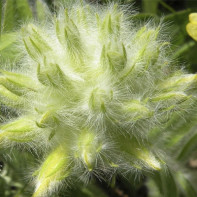Astragalus: therapeutic properties and contraindications
People do not accidentally call astragalus herb immortality. This legendary plant has exceptional properties that have been used for thousands of years to treat various diseases. Ancient Greek physician Dioscorides, who laid the foundations of modern pharmacology, gave the flower such an unusual name for the resemblance of its bean-shaped seeds to dice, which in ancient times were made from a ram's ankle. This comparison makes sense because the Latin term "Astragalus" comes from the Greek name for dice.
- Chemical composition
- What it looks like and where it grows
- Types of
- Harvesting and storage
- Therapeutic properties of astragalus woolly-flowered
- For Women
- For Men
- For children
- When losing weight
- Astragalus in folk medicine
- For diabetes
- For hypertension
- For oncology
- From allergies
- From prostatitis
- Kinds of medicinal compositions
- Infusion
- Infusion
- Decoction
- Tea
- Syrup
- Cosmetic applications
- Rejuvenating mask
- Compress
- Remedy for cellulite
- Contraindications for use
Astragalus is considered by botanists to be the most ancient plant on the planet, which is confirmed by historians. The healing herb was widely used by the Scythian tribes. But such medicine was available only for the upper class, and women and the elderly were forbidden to prepare and drink healing infusions of the miraculous herb under pain of death. But the nobles were cured of the most severe illnesses by the longevity herb. There is evidence that even infirm old men, after drinking the infusion of astragalus, vigorously jumped into the saddle.
There is a version that this legendary plant was used in the last century by prominent politicians and heads of states. Modern healers also advise preparing extracts and infusions at home to prevent colds, heart disease, digestive and other problems.
Chemical Composition
Immediately we would like to draw attention to the fact that astragalus is a whole group of shrubs and herbaceous plants, in which in total there are more than a thousand and a half species. Therefore, the chemical composition of each variety has its own characteristics. But since the official medicine recognizes only two subspecies - woolly-flowered and webbed astragalus, let's take a closer look at their composition. Although at the moment the chemical formula of the medicinal herb is still poorly studied, the presence of the following biologically active substances is established precisely.
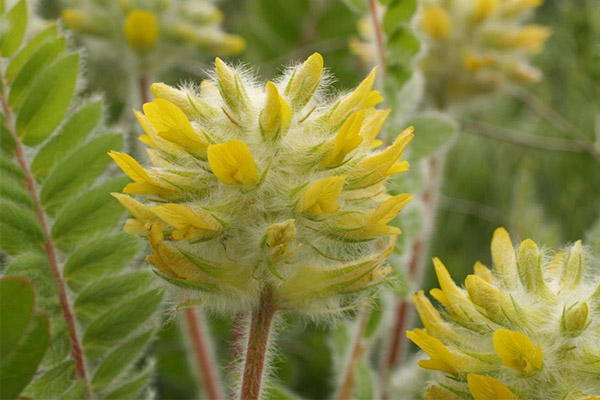
The vitamin group includes ascorbic acid, tocopherol (vitamin E), folic acid (B9), retinol (A).
Mineral elements. Scientists have proven the ability of astragalus to accumulate gold and even heavy metals such as strontium. Of this group of substances, the plant contains barium, manganese, molybdenum, iron and a number of other elements. Of the non-metallic elements, selenium is the most valuable, as well as silicon and phosphorus.
In addition to these main groups of substances, in different parts of astragalus revealed the presence of such important components as:
- Flavonoids - have pronounced anti-cancer properties.
- Organic acids are involved in almost all biochemical processes in the body.
- Polysaccharides are considered to be the main sources of energy necessary for metabolic processes.
- Tannins - natural high-molecular compounds, providing purification of the body from toxins and pathogenic microflora.
- Essential oils - soothe inflammation, soften the skin, calm the nervous system and have antiseptic properties.
- Alkaloids - have sedative and analgesic properties.
- Phytosterols - these substances astragalus synthesizes itself, they stabilize the immune system, regulate cholesterol levels.
In addition to the listed active components, astragalus is rich in fiber and carbohydrates, which should be considered when you want to use the plant for medicinal purposes.
Important note: the presence of natural sugars in large quantities does not mean that the plant should not be used by overweight people and diabetics. On the contrary, healing compositions based on this herb regulate glucose levels and improve metabolism, which promotes weight loss.
How it looks and where it grows
The herb astragalus represents one of the most numerous families - the legume family. Depending on the subspecies, the plant can be perennial or annual.
Species diversity is reflected in the external signs and life form of astragalus: more often it is a grass and small shrubs, less often - small semi-shrubs.
Equally rich is the collection of names, in which the national affiliation of the territory where this or that subspecies grows is clearly traced. For example, in Korea the plant is known as "hwang-gi", in Japan it is called "taituriogi", in areas of Tibet - "nyang-ar". In our country, astragalus has also received many metaphorical names: royal grass, Chinese ginseng, cat pea, yellow root.
Despite such a variety of sonorous nicknames, all species have similar features that unite them into one family. Let's take a look at the characteristics of this plant:
- The roots are an entire system of a central dense rhizome and numerous offshoots that go deep underground.
- Leaves are small, oblong in shape, arranged in pairs or singly.
- The inflorescences are very similar in appearance to acacia flowers. They can be white or purple in color, but more often there is an astragalus with small yellow flowers, collected in a bell-like bud-flower.
- The flowering period of the Chinese ginseng begins at the end of May and in July it is time for fruiting.
- The fruits of astragalus are in the form of a rounded pod, which is typical of all legumes. When the seeds ripen, the capsule often opens spontaneously, and then the beans fall into the ground.
- Area of distribution. Representatives of this genus can be found practically in all corners of the globe, but the plant is more favorable for regions with a temperate climate. But there is a unique feature - the culture likes to settle in places where there are uranium and manganese ores. Such preferences are due to the fact that astragalus is particularly attracted to the noble metal, and uranium and manganese are companions of gold.
In all, there are about 1600 species of astragalus in the world, with about nine hundred found in the CIS countries. Mostly distributed yellow root in the regions of Central Asia. Only on the territory of Kazakhstan grows more than 300 species.
Species
Despite the species diversity, 11 varieties of astragalus are already in the Red Book. As already noted, only two species of this legume plant are officially used by the pharmaceutical industry in the production of medicines.
Let us list those species that occur in Russia and neighboring countries:
- Sandy astragalus is found in countries with temperate climates, in Russia it grows in the middle belt. It likes to settle along roads, near rivers. The plant is included in the regional Red Books. Widely used in folk medicine.
- The Danish subspecies is a low perennial with bright purple inflorescences. It is found in Krasnodar Territory, the Far East and the Caucasus. The plant covers large areas in Belarus and Ukraine. This species likes steppes and rocky mountain slopes. All parts of the Danish astragalus are used in folk medicine.
- The ovate astragalus is a herbaceous plant that is only 5-6 cm tall. It gets its name because of its oval white fruits. It is not used for medicinal purposes.
- The licorice subspecies is highly valued in Chinese and Tibetan medicine. In the CIS countries it is found in Ukraine and the Caucasus and likes to settle in oak and pine forests. It is believed that its medicinal properties are not inferior to those of ginseng. It is one of the tallest species, reaching up to 90 cm. Licorice astragalus has large leaves and elongated flowers. Medicinal raw materials are harvested during flowering and bean formation.
- Woolly astragalus is a wild perennial that is very much in demand in medicine. This species is characterized by the abundance of inflorescences and is found mainly in the steppe expanses of southern Russia. Today, this subspecies is specially cultivated for medical needs.
- The webbed astragalus is popularly called the "yellow prince" for its ability to have a powerful tonic effect on the body. The species is also very much in demand in medicine. This herbaceous perennial, unlike its family counterparts, likes sun and open areas.
- The marsh subspecies lives mainly in Siberia and the Far East. It is a herbaceous perennial with a height of one meter or more. Its inflorescences are represented by fluffy tassels. Astragalus swamp is used for home treatment of gynecological problems and diseases of the gastrointestinal tract.
- Permian subspecies occurs very rarely and only in the Urals. It is a long-lived species, as its age often crosses the 30-year barrier. This rare species is not used in medicine.
Not all medicinal and wild-growing species are listed here. But of all this plant diversity, of great interest, as already mentioned, are the species of webbed and woolly-flowered astragalus.
Collection and storage
For medicinal purposes and in cosmetology, both the ground part of astragalus and its roots are used. To collect plant material, it is necessary to select specimens that grow in areas that are clean by ecological standards. That is, the grass, which has taken a fancy to live places near industrial enterprises, along roads and near large settlements, should not be harvested.
Here are some useful tips to help properly collect and preserve valuable material:
- The most favorable time to collect the ground elements of the plant is the period of active flowering.
- Herbalists advise to mow the grass or carefully cut, so as not to damage the root part.
- Next, you need to clean the raw material from foreign debris.
- If there are signs of powdery mildew on the plant, or other pests are seen, such specimens should be culled.
- The good quality material should be put under a tent for drying.
- If there is a drying room, then the raw material should be processed at a temperature not exceeding 55°C.
Store well dried material is better in woven bags or hermetically sealed containers. Try to protect it from substances with a powerful aroma. If you strictly follow all of the above rules, the raw material can be stored and used for a whole year.
The roots of the mugwort are harvested in late fall. The harvesting process consists of the following steps:
- The roots are carefully extracted with an ordinary shovel from the ground;
- then clean the material from the ground;
- Cut off the damaged or rotten parts;
- then wash the roots with water;
- dry the rhizomes in the shade or in a well-ventilated room;
- In an electric dryer, dry the roots at 25-28°C.
Like the dried ground parts of the herb, the roots, too, subject to the required list of conditions can be stored for up to a year.
Therapeutic properties of Astragalus woolly-flowered
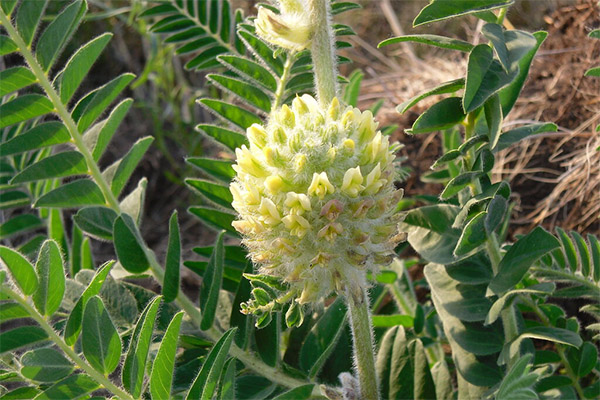
Since it is the woolly-flowered subspecies of astragalus that is widely used in medicine, it is worth describing the useful properties for humans with this fact in mind. "The royal herb" was famous in ancient times for its ability to heal even the most hopeless patients. Indeed, the track record of therapeutic capabilities includes the following actions:
- styptic;
- anti-tumor;
- hypotensive;
- sedative;
- antibacterial;
- wound-healing;
- antidiabetic;
- immunostimulant;
- diuretic;
- antioxidant
- antiviral;
- vasodilator;
- anti-aging.
Also in clinical studies it was found that the wild herb is an excellent hepatoprotector. Decoctions and infusions stimulate the heart and the brain. In some cases of poisoning, the plant acts as an antidote. As a preventive measure, it has recently been actively used to prevent cancer.
In the encyclopedia of traditional medicine there are unique recipes for the treatment of simple diseases such as the common cold, and complex pathologies, which include heart failure. But even for quite healthy people astragalus is useful, as it helps to eliminate insomnia and headaches, relieve fatigue and irritation. Let's consider what benefits the wonderful herb has for the female and male body, whether it is possible to give home remedies on its basis to children.
For women
Astragalus in ancient times earned the glory of a powerful remedy for infertility. Therefore, modern women who have problems with conception are also treated at home with infusions of this herb. The decoction is prepared according to the following recipe:
- A handful of dried grass or crushed roots pour a glass of water.
- Put the mixture on the fire and boil until half of the original volume of liquid part remains.
- The filtered warm decoction should be drunk before sexual intercourse. Such a decoction is recommended to drink until the desired pregnancy.
There is another version of making a drink: pour a glass of boiling water with 1 tbsp of dried herbs. Insist the drink as a tea, for 10 minutes. A day you can drink up to 5 cups of this infusion.
The undoubted benefit of astragalus for women is also in the cosmetic abilities of the herb. Home masks and lotions will help level minor defects on the face and wrinkles, return the ageing dermis to a young elasticity. Of course, all these effects will increase the external attractiveness of the woman.
For men
The representatives of the stronger sex should also take advantage of the capabilities of the humble plant, especially those who have sexual problems.
To do this, you need to prepare a drink of 1 tbsp. dried roots or ground part of astragalus. After a two-hour infusion, filter the solution. Drink 1/4 cup up to 4 times a day. For a sustained effect, this medicine should be taken for at least a month.
Since astragalus dilates blood vessels, it will help men who suffer from hypertension and heart problems. Drinks with the herb are good for cleansing the body, and given that there is also selenium in the composition of astragalus, with the help of the plant you can normalize the metabolism.
For children
Due to the insufficiently studied properties of the plant, children should be given medicines based on astragalus very carefully. It is better to consult with a pediatrician on this issue, so that the specialist evaluates the risks of this type of therapy. Despite its high safety, astragalus contains components that can provoke an allergic reaction. Children of infant age should not be given such preparations.
When losing weight
From the properties of astragalus described above, we can see that the plant stimulates the flow of basic processes in the body, including the acceleration of metabolism. All these actions will only contribute to productive weight loss. And the presence of vitamins and mineral elements in this difficult period will provide the body with nutrients.
Astragalus in folk medicine
Although in the pharmacy network today you can buy over-the-counter drugs that include astragalus, many supporters of natural methods of treatment prefer to take folk remedies. From the ground parts of the plant and roots, collected on their own, you can prepare simple, but very effective home remedies. We offer several effective recipes for the treatment of the most common diseases.
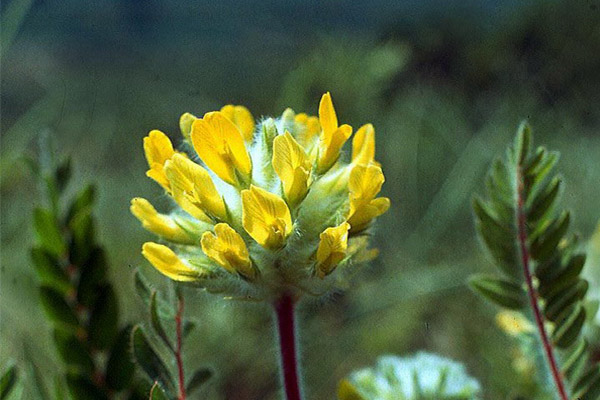
For diabetes
To normalize the level of sugar, a healing infusion should be prepared according to the following scheme:
- Take 1 tbsp of roots (crushed), pour them with a glass of boiling water.
- To activate the useful components, insist the solution 3-4 hours.
- After straining take on an empty stomach 40-50 ml three times. The course of treatment - 3 months.
Usually the therapeutic effect is observed after the first weeks of regular infusion.
When hypertension
Unpleasant clinic of hypertension will help relieve the infusion of astragalus, prepared according to the classic recipe:
- 20 g of dried herbs pour boiling water (0.2 l).
- Insist 2 hours.
- Take an infusion of 1 tbsp. before meals up to 5 times a day. The course of treatment - 3 weeks. After a short break, treatment can be resumed if the condition has not improved.
Oncology
Astragalus is especially actively used in gynecology in benign myomas. For this purpose, a concentrated solution for irrigation is prepared according to the following scheme:
- Crushed roots (6 tbsp) pour a liter of water.
- Put the mixture on the fire, boil for 10 minutes.
- When the broth cools, strain.
- For one procedure, 200 ml of the solution is enough.
- It is desirable to do 4-5 procedures per day. The course of treatment is 1.5 months.
In addition to the gynecological area, astragalus is widely used in oncology during the rehabilitation of patients after radiation and chemotherapy, as well as after surgical removal of the tumor. In such cases, an infusion is prepared from the herb or roots (as an ordinary tea). But take such a medicine should be 1 tbsp. on an empty stomach up to 5 times.
For allergies.
With allergic manifestations on the skin, means with astragalus take internally, as well as make baths or prepare ointments for external treatment, if the reaction is strong. For internal use, it is better to prepare an alcoholic infusion. Take such a medicine in 15-20 drops up to 4 times a day, until the signs of allergy disappear.
The solution for the bath is prepared at the rate of: for every 10 liters of water - 5 tbsp. dried plant material. But first, boil all the right amount of herbs in 2 liters of water for 10 minutes. After half an hour of infusion, strain the decoction and pour it into a filled bathtub with water temperature of 36-38°C. Duration of the procedure - 10 minutes. Take a bath every other day.
From prostatitis
With any form of prostatitis will help to cope with unpleasant symptoms decoction of 2 tbsp of astragalus herb, poured 1 liter of water. It is recommended to boil the mixture in an enameled container on low heat and with the lid closed. The decoction should infuse well, so it is better to pour it into a thermos and leave it until morning. At one time it is supposed to drink half a glass. The time of taking the medicine does not depend on the schedule of meals. The course of treatment is 2-3 weeks or 2 months. Decoction can also be used for mikroklizm, if diluted with water according to the formula 1:2. Such a procedure will relieve spasm, improve blood circulation in the pelvis.
Note: All formulations suggested here are recommended to be used after consultation with a physician. The astragalus has many possibilities, but the compositions based on it are not medicines in the literal sense of the word.
Types of healing compositions
Liquid dosage forms based on the grass and roots of astragalus are most often used in folk medicine. Their popularity is due not only to the strong therapeutic effect, but also to the simplicity of preparation.

Infusion
Depending on the disease, the infusion is prepared according to different schemes. The traditional version: for 2 tablespoons of raw materials - 200 ml of water. Pour the herbal part with boiling water in the specified volume. Then let the composition to stand on a water bath for a quarter of an hour. When the infusion cools a little, strain and bring the volume to the original 200 ml. It's a good tonic and prophylactic. Drink this infusion courses of 1.5 months. Single dose - 2 tablespoons.
Tincture
Astragalus herb or rhizome infused with vodka is considered a universal remedy that can be taken internally or used externally. Recipe:
- 40 g of roots pour 0.5 l of vodka.
- Close the bottle with a cork and place in a dark place for 10 days.
- Shake the bottle daily.
- When the tincture is ready to strain.
- Take 20-30 drops before meals.
Decoction
To prepare a healing decoction from the roots of astragalus, you must first grind them, or better to bring them to powder. Then take a spoonful of such a plant preparation, pour a glass of steep boiling water and immediately put to simmer on a small fire, but it is better to do on a water bath. In this state, the solution should reach readiness for half an hour. When it cools, filter it. The dose per reception is 2 tbsp.
Tea
Tea with longevity herb is useful for people with a weakened immune system. The drink is prepared as an ordinary tea, the only difference is that instead of brewing dry roots are used. The ratio of ingredients is as follows: 0.5 liter of water - 1 tbsp. raw materials.
Important: Such tea should not be drunk at a high temperature.
Syrup
It is impossible to prepare syrup from astragalus at home, and it is not safe, even if there was such a way. This is explained by the fact that the plants, which go to prepare the syrup, are grown in specially designated plots according to the technology, when fertilizers with selenium are added to the soil. When the vegetation is completed, astragalus stems and roots are harvested. They are subsequently used to make a syrup. But in the pharmacy you can freely buy the sweet medicine. Syrup Astragalus is used for therapeutic and preventive purposes. The dosage for adults is 10-15 drops per dose, and for children - a drop of syrup per year of life. That is, a three-year-old baby can be given 3 drops of syrup.
Use in cosmetology
Many cosmetologists not without reason call the herb astragalus a source of youth and beauty. After all, this unique herb is capable not only to heal, but also to make an attractive woman of any age. The complex of actions, which are based on the rich composition of the herb, create the rosiest prospects for its use in home cosmetology.
Here are just a few simple recipes that every woman should take note of.
Rejuvenating mask
Mix 1 tbsp. infusion of grass or astragalus roots, prepared according to the classic recipe, with honey and cottage cheese (1 tsp. each). Mix well, and the resulting mass of an even layer applied to the face. After 15 minutes rinse the mask.
Compress .
This versatile procedure will help to improve the condition of problematic dermis and smooth out fine lines. Soak a gauze napkin with a warm infusion of astragalus herb, and then place it on your face. Every 5 minutes you need to wet the napkin. The whole procedure should ideally last 20 minutes.
A remedy for cellulite
The basis is also taken astragalus infusion and honey. Both components in equal proportions should be mixed, and then the resulting composition is applied to the problem areas, wrap everything with polyethylene. After half an hour, rinse off.
Contraindications for use
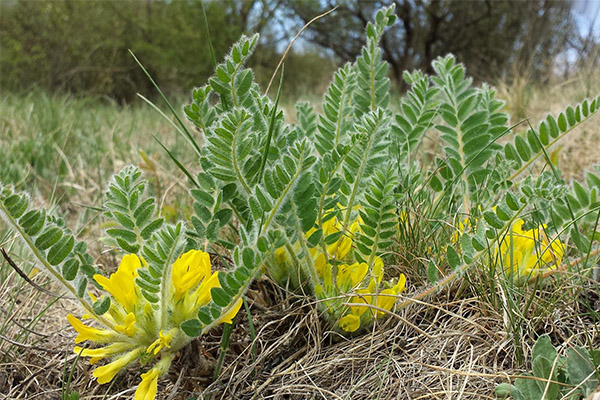
A close acquaintance with the unique plant gives a full picture of its useful qualities, which can provide invaluable help to any person. But, as we know, even the moon has a downside, a dark side. Although astragalus has not been studied enough, but contraindications to its use have been established. Drugs based on it should not be taken:
- Pregnant and lactating women.
- Persons with an individual intolerance to any component that is part of the plant.
- Children of infants and young children (except for pharmacy syrup).
Very carefully should be taken decoctions and infusions for patients with hypertension of the second degree of severity. In other cases, you can be treated by adhering to the recommended doses and rules for taking medicines with astragalus.
The variety of forms and species of astragalus strikes the imagination, but at the same time makes you wonder how generously nature bestows its riches on man. The value of the healing herb cannot be expressed in monetary terms, since the true value of health has not yet been able to determine anyone.
«Important: All information on this site is provided solely for introductory purposes. Consult with a health care professional before using any recommendations. health care professional before applying any of the recommendations. Neither the editors nor the authors shall be held liable for any possible harm caused by materials."

